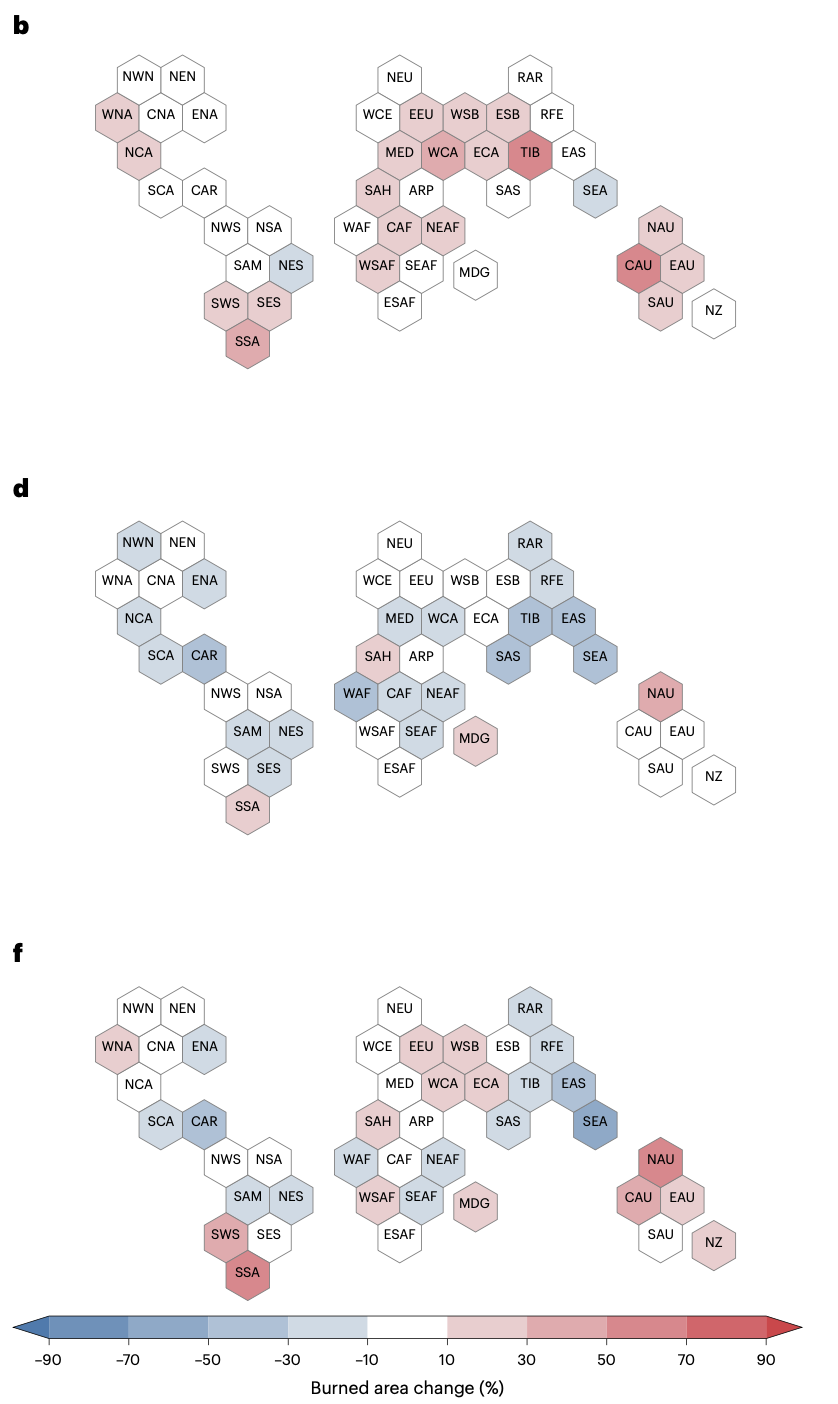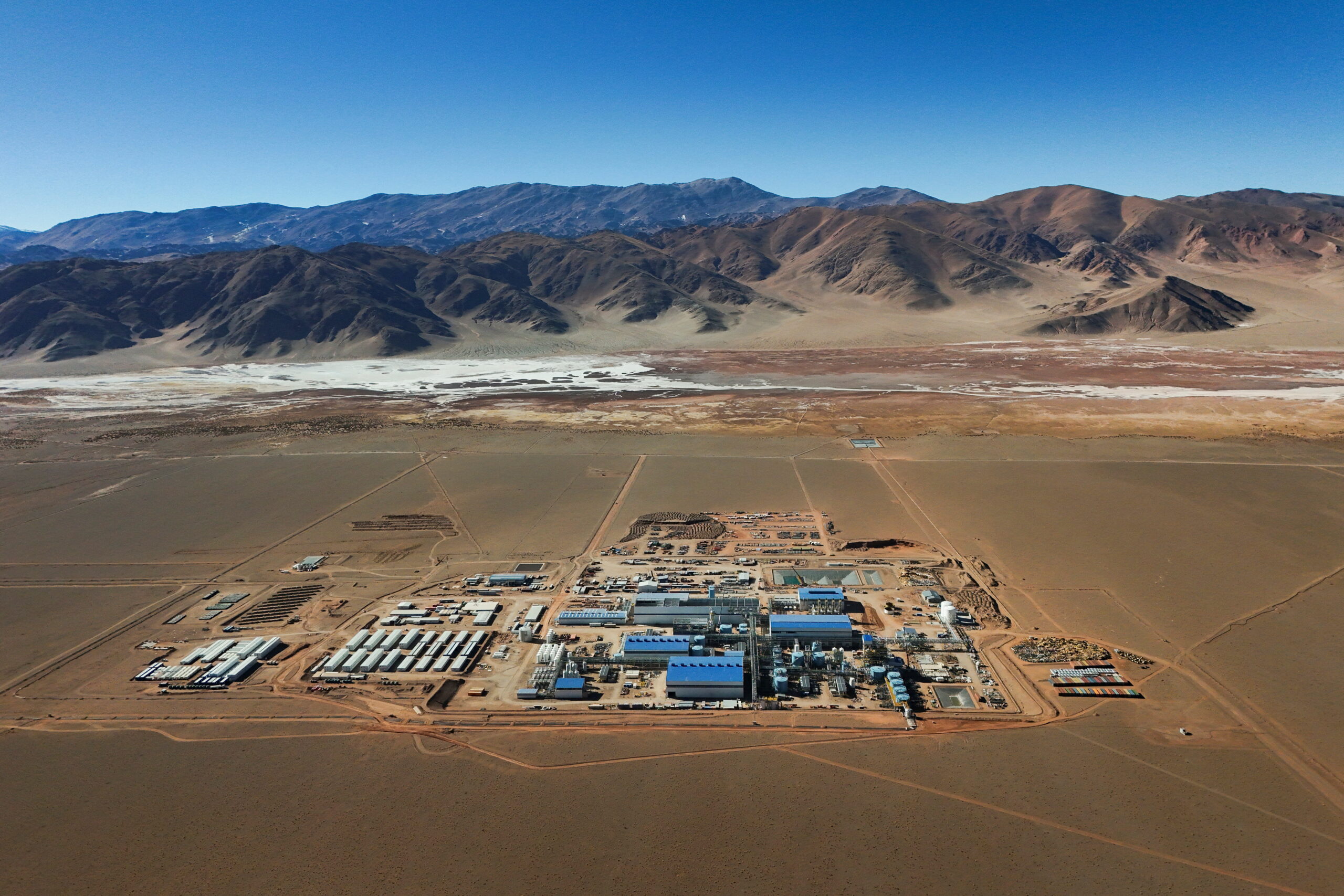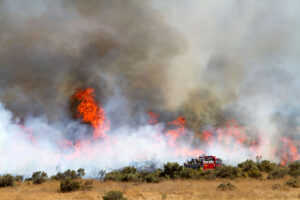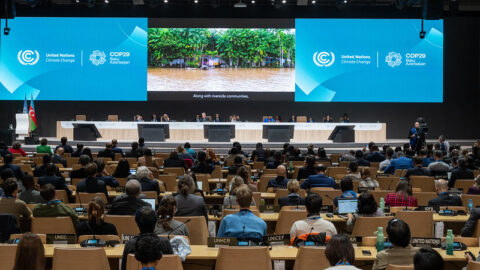A decline in the area burned globally by wildfires over the 20th century due to land-use change has almost entirely been offset by the increase caused by global warming, a new study says.
The paper, published in Nature Climate Change, is the first attribution study to assess the impacts of climate change and land-use change on “global burned area”.
It finds that changes in population distribution and land use over the 20th century – including forest fragmentation and the conversion of land for urban development and agriculture – have suppressed wildfires, driving down global burned area by 19%.
However, this decline has been hindered by human-caused warming, which has expanded the area burned by 16% through increasingly hot and dry conditions across much of the world.
As a result, the global burned area has declined just 5% over the past 100 years.
Despite the worldwide decline overall, the study finds that climate change has driven increases in burned area of 29% in south-eastern South America, 22% in northern Australia, 18% in west Siberia and 15% in western North America.
This study is the “key missing piece to the puzzle of tracking anthropogenic emissions”, according to Dr Matthew Jones – an independent researcher who was not involved in the study.
Jones, who works with on the annual Global Carbon Budget (GCP), tells Carbon Brief that this study is a “major step forward in modelling the extent of additional, human-related fires”. He notes that until now, projects like the GCB have “been forced to assume that all fire emissions are natural, therefore underestimating the effect of people on the global carbon cycle”.
Burned area paradox
Australia’s “black summer” bushfires of 2020-21 are one of the continent’s most intense and damaging fire seasons on record. The fires burned around almost 25m hectares of land, killed more than 30 people and released more CO2 than the combined annual emissions of over 100 countries.

Researchers from the World Weather Attribution (WWA) service published a “rapid attribution” study on Australia’s wildfires. They find the likelihood of Australia experiencing weather conditions like those in the lead-up to its 2020-21 fires has increased by at least 30% since 1900 as a result of climate change.
Similarly, WWA found that climate change more than doubled the likelihood of extreme fire weather conditions that led to unprecedented fires in eastern Canada in 2023. And the hot, dry and windy conditions that drove the devastating Pantanal wildfires in 2024 were 40% more intense due to climate change.
Attribution studies make it clear that climate change is making individual wildfires more intense and frequent. However, data shows that, overall, the area burned globally by fires is decreasing.
Dr Matthew Jones is an independent researcher who works with the Natural Environment Research Council and Global Carbon Project. He is the lead author of a study published last week, which finds that forest fire carbon emissions increased by 60% globally over 2001-23.
He tells Carbon Brief there climate change is does not provide the whole picture when it comes to global burned area, noting that human activity can impact wildfires in many ways:
“Wildfires are a natural phenomenon, but they are made increasingly likely by human-induced climate change and they are also influenced by people, who manage much of Earth’s land area and also alter rates of fire ignition.
“Fire scientists have long grappled with the troublesome task of separating out the additional fires that people are causing, over and above the fires that would have happened naturally.”
Attributing burned area
Seppe Lampe is a doctoral student at Vrije University Brussels department of water and climate and co-lead author on the study. He tells Carbon Brief that “this is the first study that actually attributes and quantifies how much climate change has affected burned area all over the world”.
The authors use seven “fire-vegetation models” from the Inter-Sectoral Impact Model Intercomparison Project to carry out the attribution study, which compares wildfires in today’s climate with wildfires in a counterfactual world without human-caused climate change.
To assess the impact of climate change on global burned area, the authors run models of the present-day climate (2003-19), both with and without the impacts of climate change. They then compare the results to isolate the impacts of climate change on global burned area.
To study the impact of “direct human forcing” – defined as land-use change, land management and population density – they compare simulations of the world in the early-industrial period (1901-17) and a present day world (2003-19) without the impact of climate change. In these simulations, the authors do not include any long-term changes in climate, so the only differences are in land use and population change.
The maps below show the percentage change in burned area due to climate change (top), direct human forcing (middle) and both (bottom). Red indicates an increase in percentage burned area and blue indicates a decrease. White indicates that there has been little change in the percentage of burned area. The map divides the world into hexagonal regions, as used by the Intergovernmental Panel on Climate Change (IPCC).

Climate and land-use change
The study finds that climate change has driven an increase in burned area in most IPCC regions, with only eight of the 42 regions showing a decrease in burned area due to the changing climate.
Lampe explains that the climate-driven decrease in burned area in regions such as south-east Asia could be due to factors such as changing rainfall patterns.
Many regions have seen more than a 10% increase in burned area due to climate change alone, including all IPCC regions in Australia and several regions in South America, Siberia and North America, the study adds.
The authors find that on average, climate change has driven a 16% increase in burned area globally and increased the probability of experiencing months with above-average global burned area by 22%.
The area of land that would be burned in the two most-active fire months of the year in a world without climate change is now expected for four months every year, the authors add.
The authors also find that the impact of climate change on burned area is accelerating over time, increasing most rapidly after the 1970s. Central Australia has seen the greatest increase.
Conversely, the authors find that changes in direct human forcing factors since the early industrial period have driven a 19.1% decrease in burned area.
This is due to landscape fragmentation, a reduction in fuel for fires – often seen when landscapes are converted from natural areas into urban areas or cropland – and deliberate fire management and suppression techniques, according to the study.
The decrease in burned area is mainly seen in savannah, grasslands and croplands – particularly in equatorial Asia and tropical North Africa – Lampe tells Carbon Brief. He adds:
“The global signal of burned area is actually 70% determined by what’s going on in the African savannahs. And there we see more and more savannahs being turned into cropland, which causes a decline in burned area.”
Overall, the study finds a 5% reduction in global burned area since the early 20th century.
‘Major step forward’
The study shows that without the “mitigating influences” of land-use change, global burned area would probably be even higher today.
This work is a “major step forward in modelling the extent of additional, human-related fires”, Jones tells Carbon Brief. He adds:
“Up until now, projects like the Global Carbon Budget have struggled to estimate how people influence the climate through wildfire emissions. We have been forced to assume that all fire emissions are natural, therefore underestimating the effect of people on the global carbon cycle.”
He explains that this study is the “key missing piece to the puzzle of tracking anthropogenic emissions”.
Prof David Bowman is an Australian Research Council laureate fellow and the director of the transdisciplinary Fire Centre at the University of Tasmania. He tells Carbon Brief that the approach used in this study seems “valid”, but adds that wildfire modelling is “extraordinarily difficult”.
He points out a few important assumptions and caveats in the “useful” study – for example, that the authors do not consider the intensity of fires.
Bowman also warns that the decline in global burned area “has been used for political purposes deflecting attention from the escalating wildfire crisis”.
Dr Maria Barbosa – a researcher at the Universidade Federal de São Carlos, who was not involved in the study – tells Carbon Brief that the study “provides valuable insights into how fire regimes are likely to shift”.
Barbosa warns that “we are currently failing to prepare for the upcoming fire seasons”, and says that governments need to invest in early warning systems, improve land-use planning to reduce fire risks and strengthen policies for forest management and restoration.
Lampe tells Carbon Brief that the findings of this study could help to inform regional policymakers and could “have significance for loss and damage”.
The post Climate change almost wipes out decline in global area burned by wildfires appeared first on Carbon Brief.
Climate change almost wipes out decline in global area burned by wildfires
Climate Change
Efforts to green lithium extraction face scrutiny over water use
Mining companies are showcasing new technologies which they say could extract more lithium – a key ingredient for electric vehicle (EV) batteries – from South America’s vast, dry salt flats with lower environmental impacts.
But environmentalists question whether the expensive technology is ready to be rolled out at scale, while scientists warn it could worsen the depletion of scarce freshwater resources in the region and say more research is needed.
The “lithium triangle” – an area spanning Argentina, Bolivia and Chile – holds more than half of the world’s known lithium reserves. Here, lithium is found in salty brine beneath the region’s salt flats, which are among some of the driest places on Earth.
Lithium mining in the region has soared, driven by booming demand to manufacture batteries for EVs and large-scale energy storage.
Mining companies drill into the flats and pump the mineral-rich brine to the surface, where it is left under the sun in giant evaporation pools for 18 months until the lithium is concentrated enough to be extracted.
The technique is relatively cheap but requires vast amounts of land and water. More than 90% of the brine’s original water content is lost to evaporation and freshwater is needed at different stages of the process.
One study suggested that the Atacama Salt Flat in Chile is sinking by up to 2 centimetres a year because lithium-rich brine is being pumped at a faster rate than aquifers are being recharged.
Lithium extraction in the region has led to repeated conflicts with local communities, who fear the impact of the industry on local water supplies and the region’s fragile ecosystem.
The lithium industry’s answer is direct lithium extraction (DLE), a group of technologies that selectively extracts the silvery metal from brine without the need for vast open-air evaporation ponds. DLE, it argues, can reduce both land and water use.
Direct lithium extraction investment is growing
The technology is gaining considerable attention from mining companies, investors and governments as a way to reduce the industry’s environmental impacts while recovering more lithium from brine.
DLE investment is expected to grow at twice the pace of the lithium market at large, according to research firm IDTechX.
There are around a dozen DLE projects at different stages of development across South America. The Chilean government has made it a central pillar of its latest National Lithium Strategy, mandating its use in new mining projects.
Last year, French company Eramet opened Centenario Ratones in northern Argentina, the first plant in the world to attempt to extract lithium solely using DLE.
Eramet’s lithium extraction plant is widely seen as a major test of the technology. “Everyone is on the edge of their seats to see how this progresses,” said Federico Gay, a lithium analyst at Benchmark Mineral Intelligence. “If they prove to be successful, I’m sure more capital will venture into the DLE space,” he said.
More than 70 different technologies are classified as DLE. Brine is still extracted from the salt flats but is separated from the lithium using chemical compounds or sieve-like membranes before being reinjected underground.
DLE techniques have been used commercially since 1996, but only as part of a hybrid model still involving evaporation pools. Of the four plants in production making partial use of DLE, one is in Argentina and three are in China.
Reduced environmental footprint
New-generation DLE technologies have been hailed as “potentially game-changing” for addressing some of the issues of traditional brine extraction.
“DLE could potentially have a transformative impact on lithium production,” the International Lithium Association found in a recent report on the technology.
Firstly, there is no need for evaporation pools – some of which cover an area equivalent to the size of 3,000 football pitches.
“The land impact is minimal, compared to evaporation where it’s huge,” said Gay.


The process is also significantly quicker and increases lithium recovery. Roughly half of the lithium is lost during evaporation, whereas DLE can recover more than 90% of the metal in the brine.
In addition, the brine can be reinjected into the salt flats, although this is a complicated process that needs to be carefully handled to avoid damaging their hydrological balance.
However, Gay said the commissioning of a DLE plant is currently several times more expensive than a traditional lithium brine extraction plant.
“In theory it works, but in practice we only have a few examples,” Gay said. “Most of these companies are promising to break the cost curve and ramp up indefinitely. I think in the next two years it’s time to actually fulfill some of those promises.”
Freshwater concerns
However, concerns over the use of freshwater persist.
Although DLE doesn’t require the evaporation of brine water, it often needs more freshwater to clean or cool equipment.
A 2023 study published in the journal Nature reviewed 57 articles on DLE that analysed freshwater consumption. A quarter of the articles reported significantly higher use of freshwater than conventional lithium brine mining – more than 10 times higher in some cases.
“These volumes of freshwater are not available in the vicinity of [salt flats] and would even pose problems around less-arid geothermal resources,” the study found.
The company tracking energy transition minerals back to the mines
Dan Corkran, a hydrologist at the University of Massachusetts, recently published research showing that the pumping of freshwater from the salt flats had a much higher impact on local wetland ecosystems than the pumping of salty brine. “The two cannot be considered equivalent in a water footprint calculation,” he said, explaining that doing so would “obscure the true impact” of lithium extraction.
Newer DLE processes are “claiming to require little-to-no freshwater”, he added, but the impact of these technologies is yet to be thoroughly analysed.
Dried-up rivers
Last week, Indigenous communities from across South America held a summit to discuss their concerns over ongoing lithium extraction.
The meeting, organised by the Andean Wetlands Alliance, coincided with the 14th International Lithium Seminar, which brought together industry players and politicians from Argentina and beyond.
Indigenous representatives visited the nearby Hombre Muerto Salt Flat, which has borne the brunt of nearly three decades of lithium extraction. Today, a lithium plant there uses a hybrid approach including DLE and evaporation pools.
Local people say the river “dried up” in the years after the mine opened. Corkran’s study linked a 90% reduction in wetland vegetation to the lithium’s plant freshwater extraction.
Pia Marchegiani, of Argentine environmental NGO FARN, said that while DLE is being promoted by companies as a “better” technique for extraction, freshwater use remained unclear. “There are many open questions,” she said.
AI and satellite data help researchers map world’s transition minerals rush
Stronger regulations
Analysts speaking to Climate Home News have also questioned the commercial readiness of the technology.
Eramet was forced to downgrade its production projections at its DLE plant earlier this year, blaming the late commissioning of a crucial component.
Climate Home News asked Eramet for the water footprint of its DLE plant and whether its calculations excluded brine, but it did not respond.
For Eduardo Gigante, an Argentina-based lithium consultant, DLE is a “very promising technology”. But beyond the hype, it is not yet ready for large-scale deployment, he said.
Strong regulations are needed to ensure that the environmental impact of the lithium rush is taken seriously, Gigante added.
In Argentina alone, there are currently 38 proposals for new lithium mines. At least two-thirds are expected to use DLE. “If you extract a lot of water without control, this is a problem,” said Gigante. “You need strong regulations, a strong government in order to control this.”
The post Efforts to green lithium extraction face scrutiny over water use appeared first on Climate Home News.
Efforts to green lithium extraction face scrutiny over water use
Climate Change
Maryland’s Conowingo Dam Settlement Reasserts State’s Clean Water Act Authority but Revives Dredging Debate
The new agreement commits $340 million in environmental investments tied to the Conowingo Dam’s long-term operation, setting an example of successful citizen advocacy.
Maryland this month finalized a $340 million deal with Constellation Energy to relicense the Conowingo Dam in Cecil County, ending years of litigation and regulatory uncertainty. The agreement restores the state’s authority to enforce water quality standards under the Clean Water Act and sets a possible precedent for dozens of hydroelectric relicensing cases nationwide expected in coming years.
Climate Change
A Michigan Town Hopes to Stop a Data Center With a 2026 Ballot Initiative
Local officials see millions of dollars in tax revenue, but more than 950 residents who signed ballot petitions fear endless noise, pollution and higher electric rates.
This is the second of three articles about Michigan communities organizing to stop the construction of energy-intensive computing facilities.
A Michigan Town Hopes to Stop a Data Center With a 2026 Ballot Initiative
-
Climate Change2 years ago
Spanish-language misinformation on renewable energy spreads online, report shows
-
Climate Change2 months ago
Guest post: Why China is still building new coal – and when it might stop
-
Climate Change Videos2 years ago
The toxic gas flares fuelling Nigeria’s climate change – BBC News
-

 Greenhouse Gases1 year ago
Greenhouse Gases1 year ago嘉宾来稿:满足中国增长的用电需求 光伏加储能“比新建煤电更实惠”
-
Greenhouse Gases2 months ago
Guest post: Why China is still building new coal – and when it might stop
-

 Climate Change1 year ago
Climate Change1 year ago嘉宾来稿:满足中国增长的用电需求 光伏加储能“比新建煤电更实惠”
-

 Carbon Footprint2 years ago
Carbon Footprint2 years agoUS SEC’s Climate Disclosure Rules Spur Renewed Interest in Carbon Credits
-
Renewable Energy3 months ago
US Grid Strain, Possible Allete Sale









